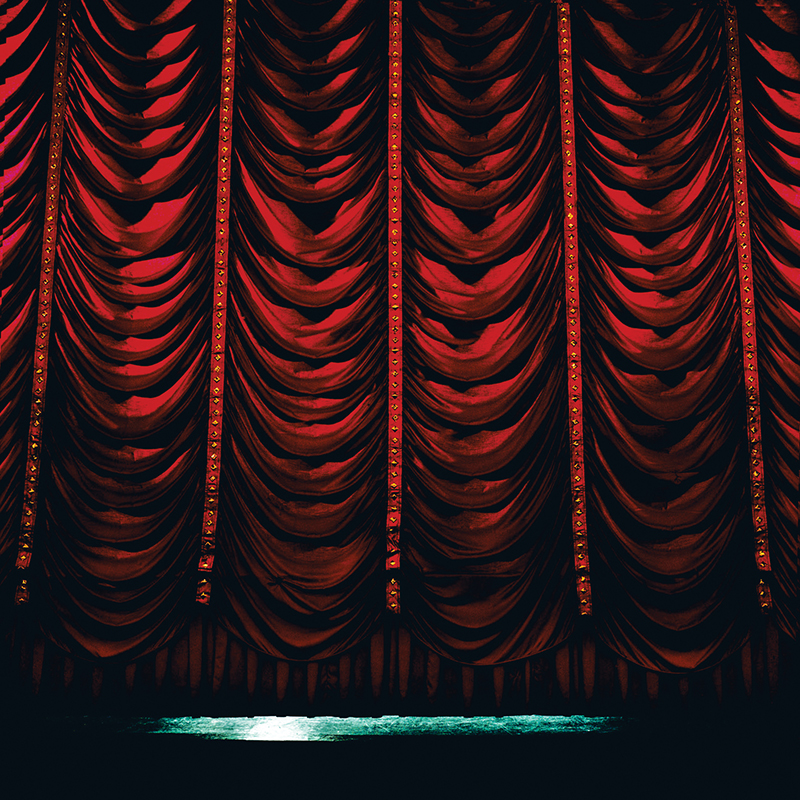 Double Act by Ceal Floyer, 2006, is comprised of a light projection, photographic gobo, and theater lamp, and gives the illusion of a theater curtain. © CEAL FLOYER; COURTESY OF 303 GALLERY, NEW YORK, LISSON GALLERY, LONDON, AND ESTHER SCHIPPER, BERLIN.
Double Act by Ceal Floyer, 2006, is comprised of a light projection, photographic gobo, and theater lamp, and gives the illusion of a theater curtain. © CEAL FLOYER; COURTESY OF 303 GALLERY, NEW YORK, LISSON GALLERY, LONDON, AND ESTHER SCHIPPER, BERLIN.
Exhibition
The Illusionists
FROM DEGAS TO HOPPER, THE THEATER STAGE HAS captivated the imagination of artists, whether for the visual appeal of its whimsical, dramatic lighting or the play between fantasy and reality. A new exhibition, Theaters of Fiction, at the Ruth and Elmer Wellin Museum of Art at Hamilton College, in upstate New York, explores how seven international contemporary artists have approached the subject through different mediums.

Avery Fisher Hall by Guillermo Kuitca, 2004. Inspired by architecture and cartography, Kuitca has re-created multiple theaters in his mixed-media pieces. COURTESY OF THE ARTIST AND SPERONE WESTWATER, NEW YORK.
The concept for the show first came to the museum’s collections curator and exhibitions manager, Katherine Alcauskas, when she began seeing parallels between several recent acquisitions by artist Lisa Kereszi, featuring empty theaters and a movie theater ticket booth, and the work of photographer Rhona Bitner, another artist in the museum’s collection, who is also drawn to theatrical spaces. “Their styles are very different,” Alcauskas says, “but in both of their work they are often looking at empty spaces of entertainment, to different ends, bringing their personal expression to that space.”
Starting with her initial pairing, Alcauskas began looking at how other artists have approached the theme of the stage, adding works by Ceal Floyer, Candida Höfer, Guillermo Kuitca, Hiroshi Sugimoto, and Carrie Mae Weems.

Untitled (FB2), from the series Stage by Rhona Bitner, 2005. © RHONA BITNER; COURTESY OF THE ARTIST.
Although the exhibition does not have a direct political bent, Alcauskas says she sees a certain relationship to the current cultural moment of fake news and the quest for authenticity. “Everywhere we look, the idea of truth is being questioned. There has been a lot of examination of the structures that are affecting how we interpret life, what is true in life and what is a construct. Although that is not our departing point, it definitely influenced my conception of the show.”

Shadows on seats, State Palace Theatre, New Orleans by Lisa Kereszi, 2001. COURTESY OF THE ARTIST.
One of the highlights of the exhibition is the installation Double Act by British artist Ceal Floyer, known for her metaphorically rich body of work. It consists of an empty, darkened room, with a theater light pointed at the opposite end of the room, spotlighting what seems to be a red stage curtain in a quintessential theater set. But upon closer inspection one realizes there is no stage or curtain, and in actuality, the image is a slide projection of the curtain. “Floyer’s work is usually very simple in its materiality, yet complex in its implications,” Alcauskas says. “The title Double Act can be read in many ways, one being that you walk in that room and you expect something to happen, but you then realize that nothing is going to happen, except the realization of the illusion of the piece. The piece deals with anticipation, expectations, assumptions—you expect something to happen, but that’s not what occurs.”

Teatro Comunale di Bologna I by Candida Höfer, 2006. RUTH AND ELMER WELLIN MUSEUM OF ART AT HAMILTON COLLEGE, CLINTON, NEW YORK, PURCHASE WITH THE WILLIAM G. ROEHRICK ’
34 ART ACQUISITION AND PRESERVATION FUND, ©
CANDIDA HÖFER, KÖLN / VG BILD-KUNST, BONN; COURTESY OF SEAN KELLY GALLERY
From acclaimed photographer Hiroshi Sugimoto, Alcauskas selected two images of the Teatro Scientifico del Bibiena in Mantua, Italy, from his recent return to the Theaters series. In this new chapter, Sugimoto brings his conceptual lens to the interiors of historic Italian opera houses. As the style of many of the American theaters featured in the initial photographs in the series were modeled on the ornate architecture of Italian opera houses, the photographer’s new focus brings this project full circle.

View of Lincoln, Lonnie, and Me – A Story in 5 Parts, video and installation by Carrie Mae Weems, 2012. © CARRIE MAE WEEMS; COURTESY OF THE ARTIST AND JACK SHAINMAN GALLERY, NEW YORK.
Since the Wellin is a college museum, the educational potential of its exhibitions is an important criterion for its programming. “We want to make art accessible to all audiences, while at the same time ensure it resonates with the academic mission of the institution,” says Tracy Adler, the museum’s Johnson-Pote Director. “We’ve connected with faculty from subjects as far-ranging as physics and literature, and of course theater and art history, among others, whose classes will be engaging with the museum throughout the run of the show.”

Teatro Scientifico del Bibiena, Mantova by Hiroshi Sugimoto, 2015. © HIROSHI SUGIMOTO, COURTESY OF THE ARTIST AND MARIAN GOODMAN GALLERY, NEW YORK.
Adding to the exhibition’s outreach, a section of the gallery has been transformed into an experimental theater as part of an annual spring program at the museum, entitled WellinWorks, which aims to connect with visitors and the community. “This space is not curated, but rather serves as an improvisational and experiential hub for pop-up performances, readings, films, and other creative activities,” Adler explains. “And within the space, there is also an opportunity to experiment with concepts introduced in the exhibition, such as the effect of lighting in conveying meaning, emotion, and mood. It’s a way of transforming the ideas in the exhibition into a hands-on relatable experience for our visitors.”












